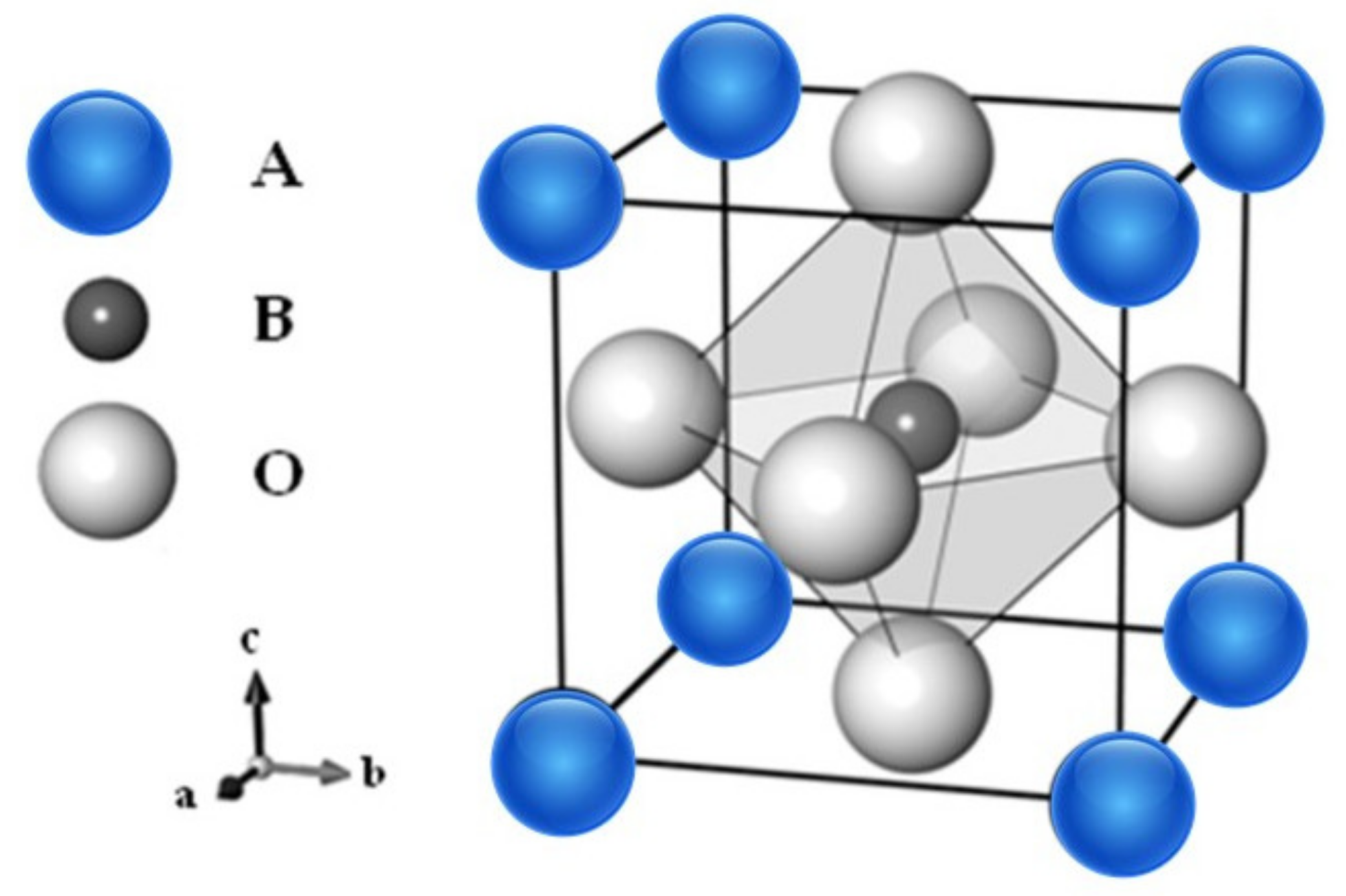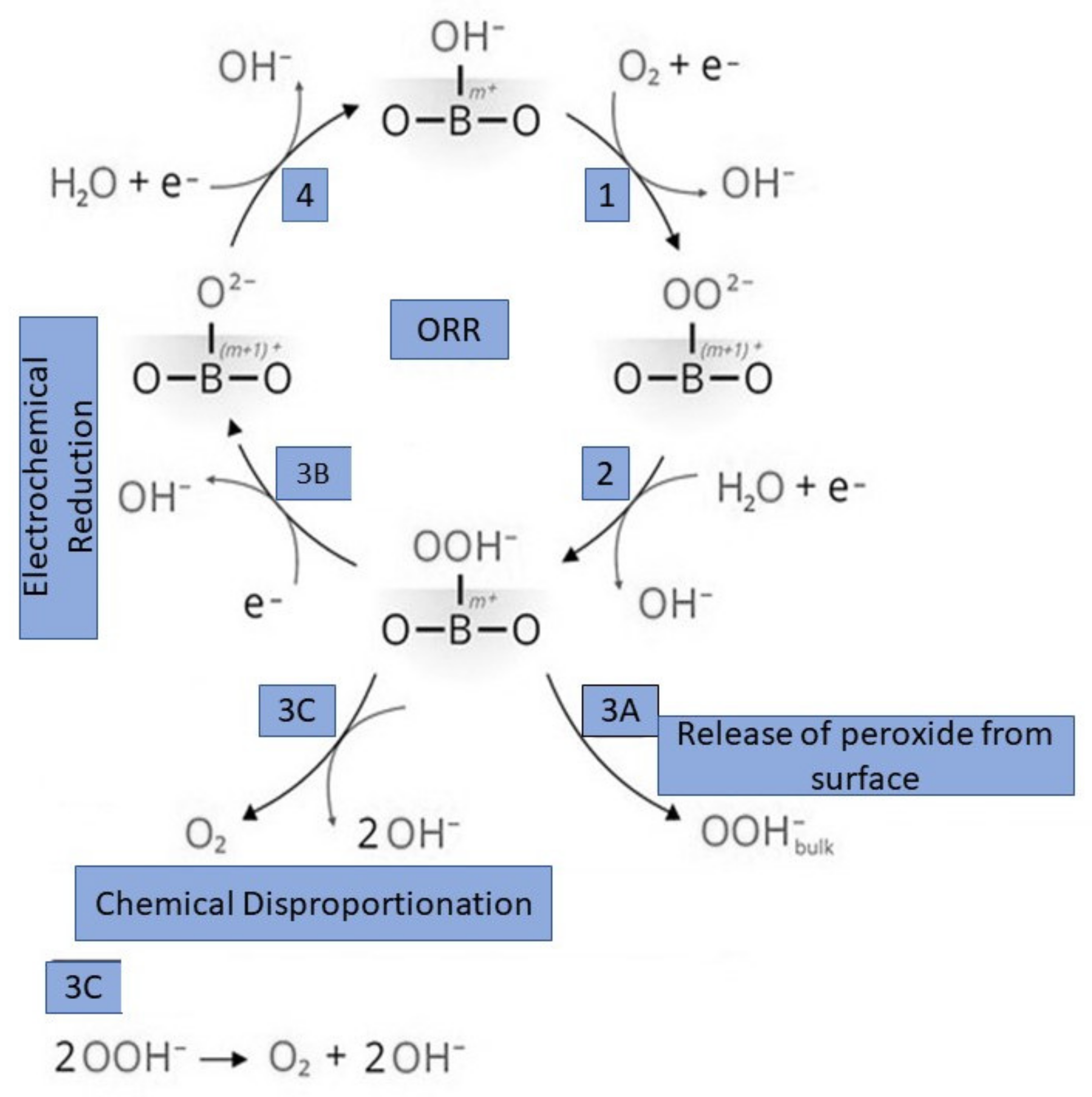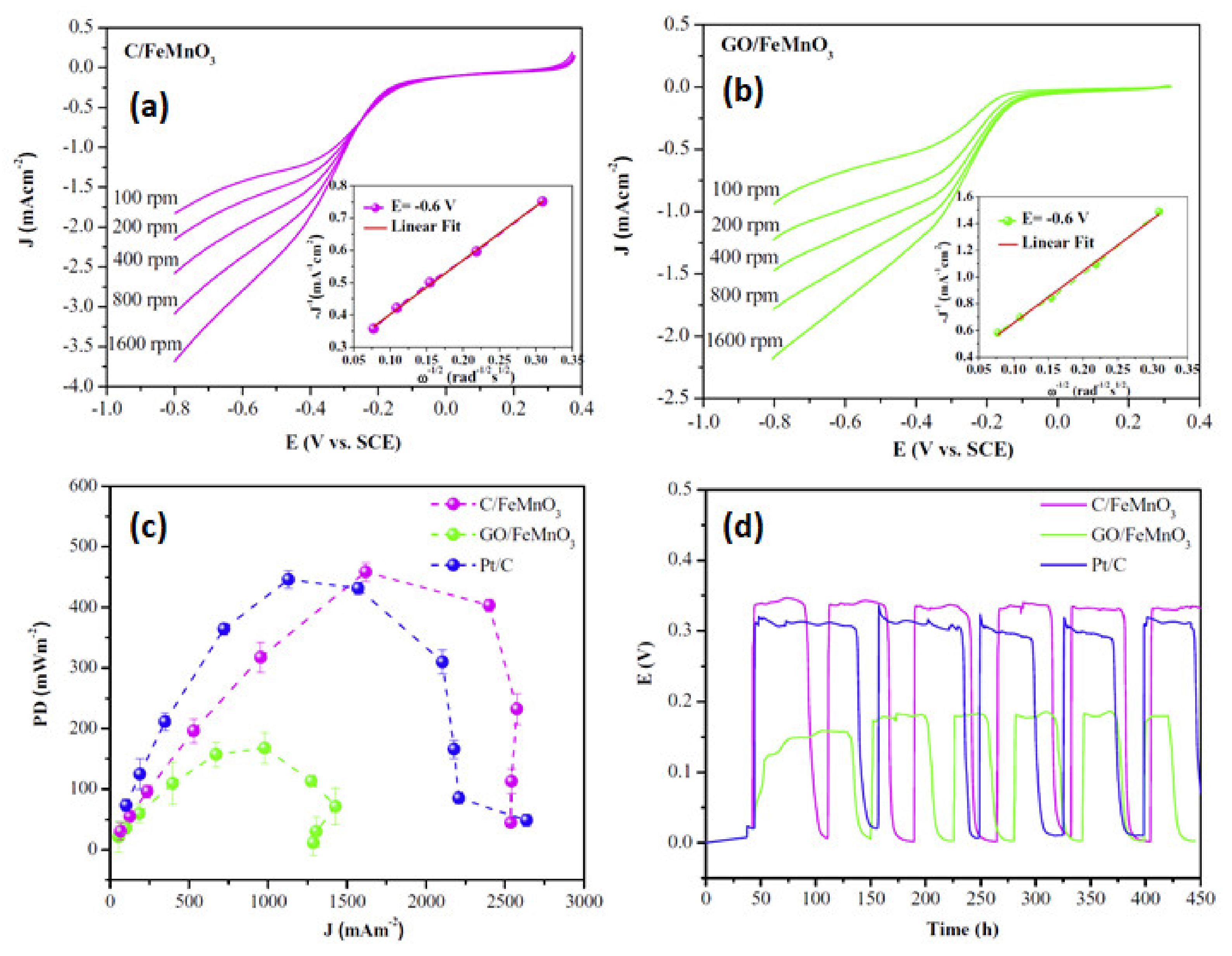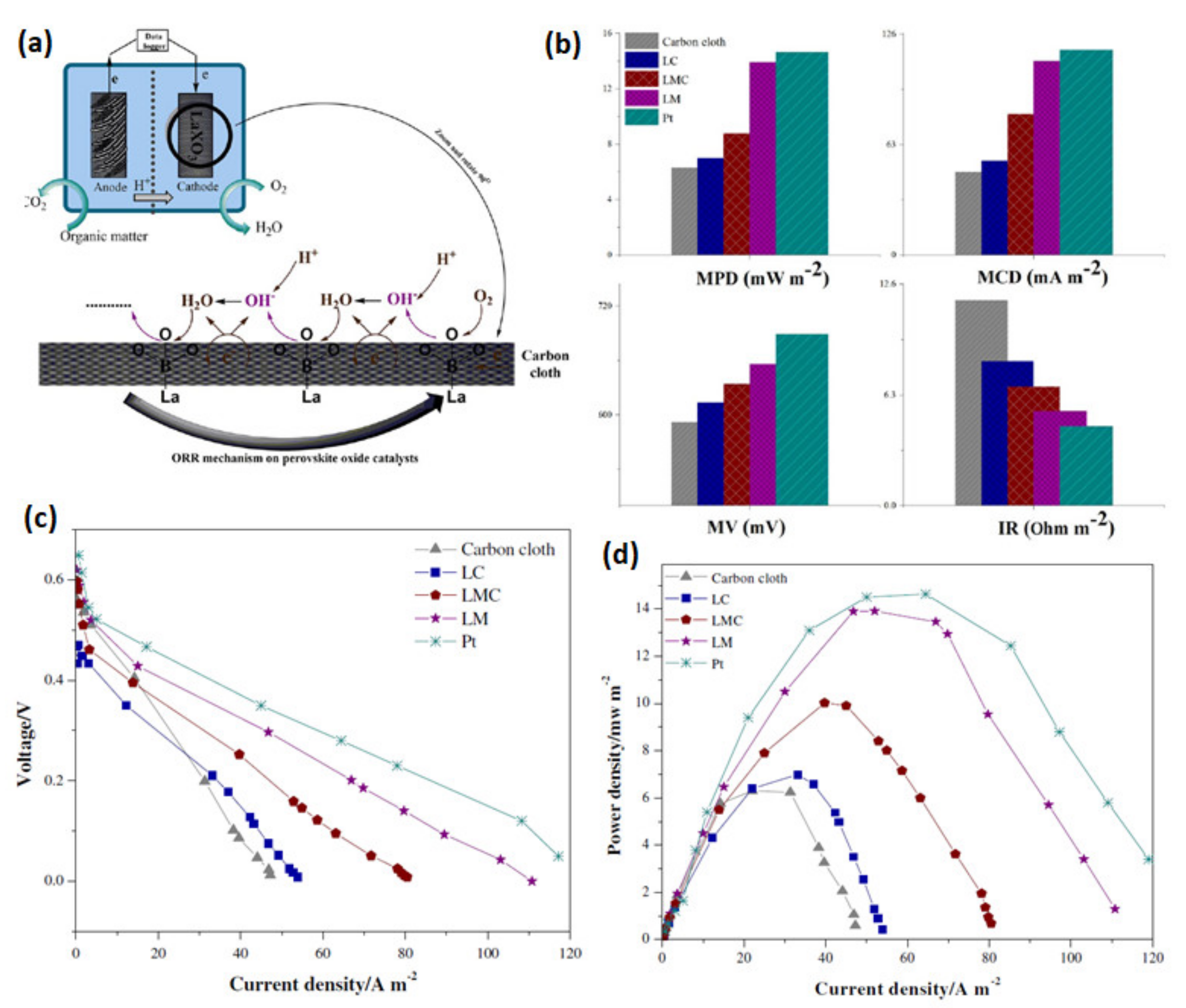Perovskite-Based Nanocomposite Electrocatalysts: An Alternative to Platinum ORR Catalyst in Microbial Fuel Cell Cathodes
Abstract
:1. Introduction
2. ORR Catalysts
2.1. Pt-Based Catalyst
2.2. Non-Pt-Based Catalysts
2.2.1. Single-Metal Oxides
2.2.2. Mixed-Metal Oxides
Spinel-Type Oxides
3. Perovskite Oxides
3.1. ORR Mechanism of Perovskite-Type Oxides
3.2. Application of Perovskite-Based ORR Electrode in MFCs
4. Summary and Perspectives
Author Contributions
Funding
Institutional Review Board Statement
Informed Consent Statement
Data Availability Statement
Conflicts of Interest
References
- Papiya, F.; Nandy, A.; Mondal, S.; Kundu, P.P. Co/Al2O3-rGO nanocomposite as cathode electrocatalyst for superior oxygen reduction in microbial fuel cell applications: The effect of nanocomposite composition. Electrochim. Acta 2017, 254, 1–13. [Google Scholar] [CrossRef]
- Papiya, F.; Pattanayak, P.; Kumar, P.; Kumar, V.; Kundu, P.P. Development of highly efficient bimetallic nanocomposite cathode catalyst, composed of Ni:Co supported sulfonated polyaniline for application in microbial fuel cells. Electrochim. Acta 2018, 282, 931–945. [Google Scholar] [CrossRef]
- Shahbazi Farahani, F.; Mecheri, B.; Reza Majidi, M.; Costa de Oliveira, M.A.; D’Epifanio, A.; Zurlo, F.; Placidi, E.; Arciprete, F.; Licoccia, S. MnOx-based electrocatalysts for enhanced oxygen reduction in microbial fuel cell air cathodes. J. Power Sources 2018, 390, 45–53. [Google Scholar] [CrossRef]
- Fu, Z.; Yan, L.; Li, K.; Ge, B.; Pu, L.; Zhang, X. Biosensors and Bioelectronics The performance and mechanism of modi fi ed activated carbon air cathode by non-stoichiometric nano Fe3O4 in the microbial fuel cell. Biosens. Bioelectron. 2015, 74, 989–995. [Google Scholar] [CrossRef]
- Nourbakhsh, F.; Mohsennia, M.; Pazouki, M. Highly efficient cathode for the microbial fuel cell using LaXO3 (X = [Co, Mn, Co0.5Mn0.5]) perovskite nanoparticles as electrocatalysts. SN Appl. Sci. 2020, 2, 391. [Google Scholar] [CrossRef] [Green Version]
- Hou, Y.; Chen, J.; He, Z. Oxygen reduction reaction catalysts used in microbial fuel cells for energy-efficient wastewater treatment: A review. Mater. Horiz. 2016, 3, 382–401. [Google Scholar] [CrossRef] [Green Version]
- Ayyaru, S.; Dharmalingam, S. Bioresource Technology Development of MFC using sulphonated polyether ether ketone (SPEEK) membrane for electricity generation from waste water. Bioresour. Technol. 2011, 102, 11167–11171. [Google Scholar] [CrossRef] [PubMed]
- Sivasankaran, A.; Sangeetha, D.; Ahn, Y. Nanocomposite membranes based on sulfonated polystyrene ethylene butylene polystyrene (SSEBS) and sulfonated SiO2 for microbial fuel cell application. Chem. Eng. J. 2016, 289, 442–451. [Google Scholar] [CrossRef]
- Ayyaru, S.; Letchoumanane, P.; Dharmalingam, S.; Raj, A. Performance of sulfonated polystyrene e ethylene e butylene e polystyrene membrane in microbial fuel cell for bioelectricity production. J. Power Sources 2012, 217, 204–208. [Google Scholar] [CrossRef]
- Ayyaru, S.; Dharmalingam, S. A study of in fl uence on nanocomposite membrane of sulfonated TiO2 and sulfonated polystyrene-ethylene-butylene-polystyrene for microbial fuel cell application. Energy 2015, 88, 202–208. [Google Scholar] [CrossRef]
- Peera, S.G.; Maiyalagan, T.; Liu, C.; Ashmath, S.; Lee, T.G.; Jiang, Z.; Mao, S. A review on carbon and non-precious metal based cathode catalysts in microbial fuel cells. Int. J. Hydrogen Energy 2021, 46, 3056–3089. [Google Scholar] [CrossRef]
- Mishra, P.; Lee, J.; Kumar, D.; Lauro, R.O.; Costa, N.; Pathania, D.; Kumar, S.; Lee, J.; Singh, L. Engineered Nanoenzymes with Multifunctional Properties for Next-Generation Biological and Environmental Applications. Adv. Funct. Mater. 2021, 2021. 23, 200–220. [Google Scholar] [CrossRef]
- Nourbakhsh, F.; Pazouki, M.; Mohsennia, M. Impact of modified electrodes on boosting power density of microbial fuel cell for effective domestic wastewater treatment: A case study of Tehran. J. Fuel Chem. Technol. 2017, 45, 871–879. [Google Scholar] [CrossRef]
- Peera, S.G.; Liu, C.; Sahu, A.K.; Selvaraj, M.; Rao, M.; Lee, T.G.; Koutavarapu, R.; Shim, J.; Singh, L. Recent Advances on Mxene-Based Electrocatalysts toward Oxygen Reduction Reaction: A focused Review. Adv. Mater. Interfaces 2021, 8, 28. [Google Scholar] [CrossRef]
- Erikson, H.; Sarapuu, A.; Tammeveski, K. Oxygen Reduction Reaction on Silver Catalysts in Alkaline Media: A Minireview. ChemElectroChem 2019, 6, 73–86. [Google Scholar] [CrossRef]
- Fan, Y.; Sharbrough, E.; Liu, H. Quantification of the internal resistance distribution of microbial fuel cells. Environ. Sci. Technol. 2008, 42, 8101–8107. [Google Scholar] [CrossRef] [PubMed]
- Chen, T.; Kalimuthu, P.; Anushya, G.; Chen, S.; Ramachandran, R.; Mariyappan, V.; Muthumala, D.C. Nanocomposite for Oxygen Evolution and Oxygen Reduction Reaction: An Overview. Materials 2021, 14, 2976. [Google Scholar] [CrossRef]
- Liu, J.; Mater, J.P.; Liu, J.; Ma, J.; Zhang, Z.; Qin, Y.; Wang, Y.; Wang, Y.; Tan, R.; Duan, X.; et al. Roadmap: Electrocatalysts for green catalytic processes Journal of Physics: Materials OPEN ACCESS 2021 Roadmap: Electrocatalysts for green catalytic processes. J. Phys. Mater. 2021, 4, 022004. [Google Scholar] [CrossRef]
- Li, M.; Zhou, J.; Bi, Y.G.; Zhou, S.Q.; Mo, C.H. Transition metals (Co, Mn, Cu) based composites as catalyst in microbial fuel cells application: The effect of catalyst composition. Chem. Eng. J. 2020, 383, 123152. [Google Scholar] [CrossRef]
- Kodali, M.; Santoro, C.; Serov, A.; Kabir, S.; Artyushkova, K.; Matanovic, I.; Atanassov, P. Air breathing cathodes for microbial fuel cell using Mn-, Fe-, Co- and Ni-containing platinum group metal-free catalysts. Electrochim. Acta 2017, 231, 115–124. [Google Scholar] [CrossRef]
- Türk, K.K.; Kruusenberg, I.; Kibena-Põldsepp, E.; Bhowmick, G.D.; Kook, M.; Tammeveski, K.; Matisen, L.; Merisalu, M.; Sammelselg, V.; Ghangrekar, M.M.; et al. Novel multi walled carbon nanotube based nitrogen impregnated Co and Fe cathode catalysts for improved microbial fuel cell performance. Int. J. Hydrogen Energy 2018, 43, 23027–23035. [Google Scholar] [CrossRef]
- Zhang, F.; Cheng, S.; Pant, D.; Van Bogaert, G.; Logan, B.E. Electrochemistry Communications Power generation using an activated carbon and metal mesh cathode in a microbial fuel cell. Electrochem. Commun. 2009, 11, 2177–2179. [Google Scholar] [CrossRef]
- Paper, R. Electrode materials for microbial fuel cells: Nanomaterial approach. Mater. Renew. Sustain. Energy 2015, 4, 21–31. [Google Scholar] [CrossRef] [Green Version]
- Yuan, H.; He, Z. Graphene-modified electrodes for enhancing the performance of microbial fuel cells. Nanoscale 2015, 7, 7022–7029. [Google Scholar] [CrossRef] [Green Version]
- Tan, L.; Liu, Z.Q.; Li, N.; Zhang, J.Y.; Zhang, L.; Chen, S. CuSe decorated carbon nanotubes as a high performance cathodecatalyst for microbial fuel cells. Electrochim. Acta 2016, 213, 283–290. [Google Scholar] [CrossRef]
- Wang, X.; Yuan, C.; Shao, C.; Zhuang, S.; Ye, J.; Li, B. Enhancing oxygen reduction reaction by using metal-free nitrogen-doped carbon black as cathode catalysts in microbial fuel cells treating wastewater. Environ. Res. 2020, 182, 109011. [Google Scholar] [CrossRef] [PubMed]
- Malyan, S.K.; Kumar, S.S.; Kishor, R.; Ghosh, P.; Kumar, A.; Singh, R.; Singh, L. Biochar for environmental sustainability in the energy-water-agroecosystem nexus. Renew. Sustain. Energy Rev. 2021, 149, 111379. [Google Scholar] [CrossRef]
- Li, S.; Ho, S.; Hua, T.; Zhou, Q.; Li, F.; Tang, J. Sustainable biochar as an electrocatalysts for the oxygen reduction reaction in microbial fuel cells. Green Energy Environ. 2021, 6, 644–659. [Google Scholar] [CrossRef]
- Allam, F.; Elnouby, M.; El-khatib, K.M. ScienceDirect Water hyacinth (Eichhornia crassipes) biochar as an alternative cathode electrocatalyst in an air-cathode single chamber microbial fuel cell. Int. J. Hydrogen Energy 2019, 45, 5911–5927. [Google Scholar] [CrossRef]
- Li, Y.; Li, Q.; Wang, H.; Zhang, L.; Wilkinson, D.P.; Zhang, J. Recent Progresses in Oxygen Reduction Reaction Electrocatalysts for Electrochemical Energy Applications. Electrochem. Energy Rev. 2019, 2, 518–538. [Google Scholar] [CrossRef] [Green Version]
- Ayyaru, S.; Mahalingam, S.; Ahn, Y. A non-noble V2O5 nanorods as an alternative cathode catalyst for microbial fuel cell applications. Int. J. Hydrogen Energy 2019, 44, 4974–4984. [Google Scholar] [CrossRef]
- Goswami, C.; Hazarika, K.K.; Bharali, P. Transition metal oxide nanocatalysts for oxygen reduction reaction. Mater. Sci. Energy Technol. 2018, 1, 117–128. [Google Scholar] [CrossRef]
- Wang, Z.-L.; Xu, D.; Xu, J.-J.; Zhang, X.-B. Oxygen electrocatalysts in metal–air batteries: from aqueous to nonaqueous electrolytes. Chem. Soc. Rev. 2014, 43, 7746–7786. [Google Scholar] [CrossRef] [PubMed]
- Dong, C.; Liu, Z.W.; Liu, J.Y.; Wang, W.C.; Cui, L.; Luo, R.C.; Guo, H.L.; Zheng, X.L.; Qiao, S.Z.; Du, X.W.; et al. Modest Oxygen-Defective Amorphous Manganese-Based Nanoparticle Mullite with Superior Overall Electrocatalytic Performance for Oxygen Reduction Reaction. Small 2017, 13, 1603903. [Google Scholar] [CrossRef]
- Zhang, T.; He, C.; Sun, F.; Ding, Y.; Wang, M.; Peng, L.; Wang, J.; Lin, Y. Co3O4 nanoparticles anchored on nitrogen-doped reduced graphene oxide as a multifunctional catalyst for H2O2 reduction, oxygen reduction and evolution reaction. Sci. Rep. 2017, 7, 43638. [Google Scholar] [CrossRef]
- Xiao, J.; Kuang, Q.; Yang, S.; Xiao, F.; Wang, S.; Guo, L. Surface Structure Dependent Electrocatalytic Activity of Co3O4 Anchored on Graphene Sheets toward Oxygen Reduction Reaction. Sci. Rep. 2013, 3, 2300. [Google Scholar] [CrossRef] [Green Version]
- Mahalingam, S.; Ayyaru, S.; Ahn, Y. Chemosphere Facile one-pot microwave assisted synthesis of rGO-CuS-ZnS hybrid nanocomposite cathode catalysts for microbial fuel cell application. Chemosphere 2021, 278, 130426. [Google Scholar] [CrossRef]
- Zhou, X.; Xu, Y.; Mei, X.; Du, N.; Jv, R.; Hu, Z.; Chen, S. Polyaniline/β-MnO2 nanocomposites as cathode electrocatalyst for oxygen reduction reaction in microbial fuel cells. Chemosphere 2018, 198, 482–491. [Google Scholar] [CrossRef]
- Dong, A.; Lee, U.; Li, J.; Park, M.G.; Seo, M.H.; Stadelmann, I.; Ricardez-sandoval, L.; Un, D.; Li, J.; Gyu, M.; et al. Self-assembly of Spinel Nano-crystals into Mesoporous Spheres as Bi-functionally Active Oxygen Reduction and Evolution Electrocatalysts. ChemSusChem 2017, 10, 2258–2266. [Google Scholar] [CrossRef]
- Bu, Y.; Jang, H.; Gwon, O.; Kim, S.H.; Joo, S.H.; Nam, G.; Kim, S.; Qin, Y.; Zhong, Q.; Kwak, S.K.; et al. Synergistic interaction of perovskite oxides and N-doped graphene in versatile electrocatalyst. J. Mater. Chem. A 2019, 7, 2048–2054. [Google Scholar] [CrossRef]
- Dzara, M.J.; Christ, J.M.; Joghee, P.; Ngo, C.; Cadigan, C.A.; Bender, G.; Richards, R.M.; Hayre, R.O.; Pylypenko, S. La and Al co-doped CaMnO3 perovskite oxides: From interplay of surface properties to anion exchange membrane fuel cell performance. J. Power Sources 2018, 375, 265–276. [Google Scholar] [CrossRef]
- Wang, X.T.; Ouyang, T.; Wang, L.; Zhong, J.H.; Liu, Z.Q. Surface Reorganization on Electrochemically-Induced Zn–Ni–Co Spinel Oxides for Enhanced Oxygen Electrocatalysis. Angew. Chem. 2020, 132, 6554–6561. [Google Scholar] [CrossRef]
- Onrubia-Calvo, J.A.; Pereda-Ayo, B.; González-Velasco, J.R. Perovskite-Based Catalysts as Efficient, Durable, and Economical NOx Storage and Reduction Systems. Catalysts 2020, 10, 208. [Google Scholar] [CrossRef] [Green Version]
- Kumar, A.; Kumar, A.; Krishnan, V. Perovskite Oxide Based Materials for Energy and Environment-Oriented Photocatalysis. ACS Catal. 2020, 10, 10253–10315. [Google Scholar] [CrossRef]
- Fierro, J.L.G. Chemical Structures and Performance of Perovskite Oxides. Chem. Rev. 2017, 101, 1981–2018. [Google Scholar]
- Suntivich, J.; Gasteiger, H.A.; Yabuuchi, N.; Nakanishi, H.; Goodenough, J.B.; Shao-Horn, Y. Design principles for oxygen-reduction activity on perovskite oxide catalysts for fuel cells and metal-air batteries. Nat. Chem. 2011, 3, 546–550. [Google Scholar] [CrossRef] [PubMed]
- Beall, C.E.; Fabbri, E.; Schmidt, T.J. Perovskite Oxide Based Electrodes for the Oxygen Reduction and Evolution Reactions: The Underlying Mechanism. ACS Catal. 2021, 11, 3094–3114. [Google Scholar] [CrossRef]
- Risch, M. Perovskite electrocatalysts for the Oxygen reduction reaction in alkaline media. Catalysts 2017, 7, 154. [Google Scholar] [CrossRef] [Green Version]
- Xue, Y.; Sun, S.; Wang, Q.; Dong, Z.; Liu, Z. Transition metal oxide-based oxygen reduction reaction electrocatalysts for energy conversion systems with aqueous electrolytes. J. Mater. Chem. A 2018, 6, 10596–10626. [Google Scholar] [CrossRef]
- Ji, Q.; Bi, L.; Zhang, J.; Cao, H.; Zhao, X.S. The role of oxygen vacancies of ABO3 perovskite oxides in the oxygen reduction reaction. Energy Environ. Sci. 2020, 13, 1408–1428. [Google Scholar] [CrossRef]
- Shahbazi Farahani, F.; Mecheri, B.; Majidi, M.R.; Placidi, E.; D’Epifanio, A. Carbon-supported Fe/Mn-based perovskite-type oxides boost oxygen reduction in bioelectrochemical systems. Carbon 2019, 145, 716–724. [Google Scholar] [CrossRef]
- Dai, Y.; Li, H.; Wang, Y.; Zhong, K.; Zhang, H.; Yu, J.; Huang, Z.; Yan, J.; Huang, L.; Liu, X.; et al. Zn-doped CaFeO3 perovskite-derived high performed catalyst on oxygen reduction reaction in microbial fuel cells. J. Power Sources 2021, 489, 229498. [Google Scholar] [CrossRef]
- Dong, H.; Yu, H.; Wang, X.; Zhou, Q.; Sun, J. Carbon-supported perovskite oxides as oxygen reduction reaction catalyst in single chambered microbial fuel cells. J. Chem. Technol. Biotechnol. 2013, 88, 774–778. [Google Scholar] [CrossRef]
- Xu, Y.; Tsou, A.; Fu, Y.; Wang, J.; Tian, J.H.; Yang, R. Carbon-Coated Perovskite BaMnO3 Porous Nanorods with Enhanced Electrocatalytic Perporites for Oxygen Reduction and Oxygen Evolution. Electrochim. Acta 2015, 174, 551–556. [Google Scholar] [CrossRef]
- Bai, L.; Wang, X.; He, H. Preparation and characteristics of LAXSR1-XCOO3 as cathode catalysts for microbial fuel cell. In Particle Science and Engineering, Proceedings of UK–China International Particle Technology Forum IV; The Royal Society of Chemistry: London, UK, 2014; pp. 15–21. ISBN 9781849739573. [Google Scholar]









| ORR Catalyst | Matrix | Max. Power Density | Ref. Electrode | Onset Potential | Half-Wave Potential | Number of Electrons Transferred | Current Density | Reference |
|---|---|---|---|---|---|---|---|---|
| Platinum | Carbon | 783 mWm−2 | Ag/AgCl | 0.158 V | −0.193 V | 3.9 | 4.83 mAcm−2 | [52] |
| CaFeZnO3 | Carbon Cloth | 892 mWm−2 | Ag/AgCl | 0.194 V | −0.219 V | 3.94 | 5.46 mAcm−2 | [52] |
| LaMnO3 | Carbon Cloth | 14 mWm−2 | Ag/AgCl | - | - | 3.4 | 1.1 mAcm−2 | [5] |
| FeMnO3 | Graphene Oxide | 166 mWm−2 | Ag/AgCl | - | −0.22 V | 3.6 | 3.8 mAcm−2 | [51] |
| FeMnO3 | Carbon | 460 mWm−2 | Ag/AgCl | - | −0.30 V | 3.6 | 4.2 mAcm−2 | [51] |
| LaCaCoFeO3 | Carbon | 405 mWm−2 | Ag/AgCl | - | - | - | - | [53] |
| LaSrCoO3 | Carbon | 104 mWm−2 | Ag/AgCl | - | - | - | - | [55] |
| CoAl2O3 | Graphene Oxide | 548 mWm−2 | Ag/AgCl | 0.13 V | −0.15 V | - | 1.79 mAcm−2 | [1] |
| BaMnO3 | Carbon | 790 mWm−2 | Ag/AgCl | 0.19 V | −0.36 V | 3.4 | 4.84 mAcm−2 | [54] |
Publisher’s Note: MDPI stays neutral with regard to jurisdictional claims in published maps and institutional affiliations. |
© 2021 by the authors. Licensee MDPI, Basel, Switzerland. This article is an open access article distributed under the terms and conditions of the Creative Commons Attribution (CC BY) license (https://creativecommons.org/licenses/by/4.0/).
Share and Cite
Nandikes, G.; Gouse Peera, S.; Singh, L. Perovskite-Based Nanocomposite Electrocatalysts: An Alternative to Platinum ORR Catalyst in Microbial Fuel Cell Cathodes. Energies 2022, 15, 272. https://doi.org/10.3390/en15010272
Nandikes G, Gouse Peera S, Singh L. Perovskite-Based Nanocomposite Electrocatalysts: An Alternative to Platinum ORR Catalyst in Microbial Fuel Cell Cathodes. Energies. 2022; 15(1):272. https://doi.org/10.3390/en15010272
Chicago/Turabian StyleNandikes, Gopa, Shaik Gouse Peera, and Lakhveer Singh. 2022. "Perovskite-Based Nanocomposite Electrocatalysts: An Alternative to Platinum ORR Catalyst in Microbial Fuel Cell Cathodes" Energies 15, no. 1: 272. https://doi.org/10.3390/en15010272
APA StyleNandikes, G., Gouse Peera, S., & Singh, L. (2022). Perovskite-Based Nanocomposite Electrocatalysts: An Alternative to Platinum ORR Catalyst in Microbial Fuel Cell Cathodes. Energies, 15(1), 272. https://doi.org/10.3390/en15010272







